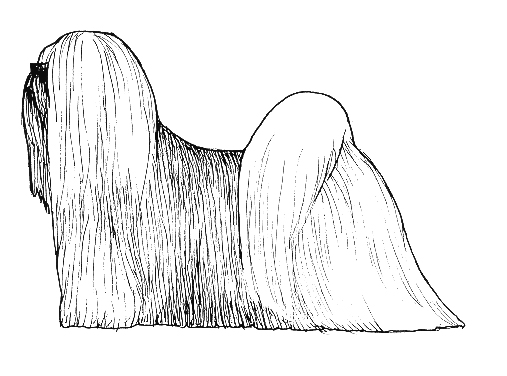Lhasa Apso
Companion Dog Group
The goals and purposes of this breed standard include: to furnish guidelines for breeders who wish to maintain the quality of their breed and to improve it; to advance this breed to a state of similarity throughout the world; and to act as a guide for judges.
Breeders and judges have the responsibility to avoid any conditions or exaggerations that are detrimental to the health, welfare, essence and soundness of this breed, and must take the responsibility to see that these are not perpetuated.
Any departure from the following should be considered a fault, and the seriousness with which the fault should be regarded should be in exact proportion to its degree and its effect upon the health and welfare of the dog and on the dog’s ability to perform its traditional work.
History
The Lhasa Apso originated in Tibet, where documentation on the breed exists from as far back as 800 B.C. They were, and still are, valued as a companion and watchdog. Originally, the dogs were kept as good luck talismans and were never sold but given away as gifts to those who the lamas held in high esteem.
The Lhasa Apso was recognized by the United Kennel Club in 1975.
General Appearance
The Lhasa Apso is a small, well balanced, sturdy and heavily coated breed. It is rectangular in outline.
Characteristics
The Lhasa Apso is gay and assertive, but cautious of strangers.
Head
SKULL
The narrow skull falls away behind the eyes. It is not flat, but on the other hand is not domed nor apple-shaped. It joins the muzzle at a moderate stop.
MUZZLE
The foreface is straight, but not square, and about 1½ inches in length. The length, measured from the tip of the nose to the eyes, is roughly about one-third of the total length of the head, measured from the nose to the back of the skull. The teeth must not show when the mouth is closed.
TEETH
A full complement of strong, white teeth meet in a level or slightly undershot bite.
EYES
Dark in color, medium size, and forward placed in the skull. They are oval in shape, with no white showing.
NOSE
The nose is black.
EARS
The pendant type ears are heavily feathered.
Neck
Strong, and well-arched.
Forequarters
The shoulders are well laid back.
FORELEGS
The forelegs are straight, and heavily furnished with hair.
Body
Longer than tall, yet well-balanced and compact. The topline is level, and the ribs extend well back in the body to a strong loin.
Hindquarters
Muscular, and well-developed.
HIND LEGS
Muscular and nicely angulated. Viewed from behind, the rear pasterns are parallel and not too close to one another.
Feet
The round, cat-like feet have firm pads, and are well feathered.
Tail
The well-feathered tail is high set and carried over the back. There may be a kink at the end.
Coat
The heavy, very dense, hard topcoat is straight and of good length. There is moderate undercoat. The head furnishings are very heavy, with a good fall over the eyes, good whiskers and a beard. Legs, forequarters, hindquarters and neck are heavily furnished.
Faults: Woolly coat. Silky coat.
Color
All colors are acceptable. Dark tips on the ears and beard may or may not be present.
Height
Heights are variable, but the desired height at the withers is about ten inches for males, with females being slightly smaller.
Gait
Easy, free, and jaunty.
Disqualifications
(A dog with a Disqualification must not be considered for placement in a conformation event, and must be reported to UKC.)
Unilateral or bilateral cryptorchid.
Viciousness or extreme shyness.
Albinism.

Looking for a Dog?
Find a dog that will fit your family.
Note: The breeders on this list are not endorsed by UKC.
Revised May 1, 2007
©Copyright 1992, United Kennel Club
